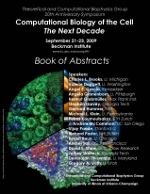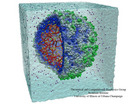TCBG Celebrates 20th Anniversary
By Celia Elliot, September 17, 2009.
In 1989, the National Center for Supercomputing Applications was barely three years old, its first massively parallel computer, Connection Machines’ CM-2, was just being installed, and Klaus Schulten, newly arrived at the University of Illinois, launched the Theoretical Biophysics Group (TBG). His overarching vision was to use the analytical tools of physics and chemistry, coupled with the horsepower of increasingly robust and sophisticated computers, to elucidate the organization and functioning of biological systems.
The TBG is now the Theoretical and Computational Biophysics Group (TCBG) and on September 21–23, it will celebrate its 20 years of achievements in characteristic Schulten fashion, by looking forward—not back.
“The idea that is important to convey,” stresses Schulten, “is not how many atoms we’ve simulated or how many processors we’ve employed, but the discoveries we will now be able to make. I’ve worked for 20 years to get to this point—to have the potent tools capable of addressing fundamental questions of how proteins assemble themselves and work in concert with other proteins to create living systems. In 1989, we could barely model the structure of a single simple protein. Now we are beginning to be able to simulate how biological molecules arrange themselves into increasingly complex assemblies that can communicate with one another and function collectively as teams to move, to change, to adapt, to become alive.”
“Computational Biology of the Cell—The Next Decade,” the TCBG’s 20th anniversary symposium, will be far from a retrospective of past achievements. Instead, it will bring together more than 200 researchers from more than 30 institutions for three full days of talks, posters, and intense discussions about the future of their discipline. Topics will range from the treatment of slow and complex conformal transitions to the challenges of petascale computing.
About the Theoretical and Computational Biophysics Group at Illinois
The TCBG, directed by Klaus Schulten and comprising faculty from physics, computer science, chemistry, pharmacology, and biophysics, combines world-class expertise in modeling and visualization with advanced computer engineering. Since 1990, the TCBG has hosted the National Institutes of Health Resource for Macromolecular Modeling and Bioinformatics, which develops algorithms and designs computational tools to unlock the secrets of living cells’ molecular machines. The TCBG also nucleates the theory efforts of Illinois’ new National Science Foundation-funded Center for the Physics of Living Cells, an NSF Physics Frontiers Center.
The mission of the TCBG is to develop new theoretical concepts and exploit the most advanced computational technologies to answer long-standing questions of biomedical relevance. Research activities focus on elucidating the structure and function of supramolecular machines in the living cell, while developing new algorithms and efficient computing tools for physical biology. Their success can be measured in a record number of citations of Schulten’s work.
In the last 20 years, the TCBG has made profound advances to the state of the art in computational biology, as Schulten has pushed the simulation of very large biopolymer systems. He and his group were the first to demonstrate that parallel computers could be practically employed to solve the classical many-body problem in biomolecular modeling, first building from scratch and programming a 60-processor forerunner to today’s supercomputers and then using it for the first simulation to reproduce consistently the behavior of a biological membrane.
In 1995, the TCBG released VMD, a molecular visualization program that displays, animates, and analyzes large biomolecular systems, using three-dimensional graphics and built-in scripting and running on a $150 game board available for PCs. VMD put powerful molecular modeling tools, which could formerly be done only on high-end workstations costing tens of thousands of dollars, into the hands of more than 100,000 registered users.
In 1998, they added NAMD, a scalable parallel molecular dynamics code that enabled interactive simulation of molecules by linking to VMD. Since then, the versatile software package has continued to evolve as more than 30,000 scientists worldwide have exploited its scalability and flexibility. Today, NAMD can simulate the behavior of complex proteins having millions of atoms, making it the world’s fastest parallel molecular dynamics program, capable of running efficiently on several thousand processors.
The TCBG received the prestigious Gordon Bell Prize in 2002 for exemplary use of a large parallel computer with NAMD. This award is given annually to recognize outstanding achievement in high-performance computing.
All software developed by the TCBG, including VMD and NAMD, is distributed free of charge to researchers. It has been used by thousands of scientists in industry and academia around the world, quickening the pace of drug discovery and unraveling problems of urgent biomedical importance, such as this year’s study of how possible mutations in viral proteins could lead to drug resistance in the A/H1N1 influenza virus.
The group achieved another important breakthrough in 2006, when Schulten and his students produced the first simulation of the atom-by-atom behavior of a complete life form, the satellite tobacco mosaic virus. By calculating the dynamic interactions of the million atoms comprising the virus and a surrounding saline solution, the group was able to show how the virus shell protects its genetic content.
“This is our ultimate goal,” said Schulten, “to be able to understand how the inert substances that make up biological molecules organize and transform themselves into something alive. It’s a bit like trying to look at the 300 million people who live in the United States, their individual behavior, to discover how they organize themselves into ever larger groups and function collectively to make our society work the way it does. We’re not able to do that yet with the entire society of molecules forming themselves into a living cell, but each year, we are getting closer.”
About Klaus Schulten
Klaus Schulten received his Diplom degree in physics from the University of Münster, Germany, in 1969, and a doctorate in chemical physics from Harvard University in 1974. He was an assistant at the Max-Planck-Institut for Biophysical Chemistry from 1974 to 1980, and professor of theoretical physics at the Technical University of Münich from 1980 to 1988. In 1988, he joined the Department of Physics at the University of Illinois. He is the founder and director of both the TCBG and the NIH Resource for Macromolecular Modeling and Bioinformatics at Illinois, and he is co-director, with experimentalist Taekjip Ha, of the Center for the Physics of Living Cells. He has held a Swanlund Chair in Physics at Illinois since 1997.
Schulten’s research applies theoretical concepts and methods from physics and chemistry to explain the “machinery” of living cells. Schulten has pioneered the development of tools and techniques that he has termed a “computational microscope.” Just as optical microscopes use light to reveal cellular details too small for the human eye to see unaided, Schulten’s experiments in silico reveal the physical structure of the molecular workings of cells. “We can now apply the laws of physics and our knowledge of chemistry to describe how these structures and materials evolve in biological functions,” said Schulten.
Schulten received the 2008 International Society of Quantum Biology and Pharmacology Award for Computational Biology. He is a fellow of the American Physical Society
Article written by Celia Elliot, Director of Ext. Affairs and Special Projects at the UIUC Department of Physics, on 9/17/2009 (8:00 am), and posted at the Physics department news web site. Pictures and some links were added by TCBG staff to the original story.






